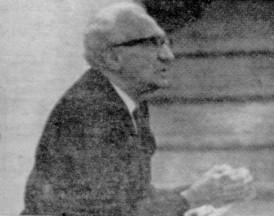
Velikovsky addresses crowd at Guyot Hall
‘Heretic’ Velikovsky sees radical solar system’
by Bruce Nickerson
Speaking before an overflow crowd of 200 in Guyot Hall last night Immanuel Velikovsky expounded his theory of a solar system much more violent than predicted by accepted theory.
Velikovsky called himself a scientific “heretic of yesterday,” but wen on to show how many of his radical predictions have been accepted by the scientific community. Several of his suggestions have been included in Apollo experiments.
He predicted a high surface temperature on Venus, discovery of radioactivity on the moon, the earth’s magnetosphere, discovery of hydrocarbons and their derivates on the moon, molten moon rocks, and moonquakes so frequent that astronauts would experience them while they were there. All of these predictions later proved true.
Velikovsky’s most radical prediction, however, has not yet received acceptance although he noted that an astronomy class at the University of California keeps one of his books on hand although not teaching from it.
In his lecture he tried to show that a planet flying through the solar system in recent astronomical times has caused changes in the earth’s climate, and the magnetic polarization of rocks.
He uses historical records from numerous ancient civilizations all over the world and geological evidence to back up his theory. In his lecture he proposed that this planet was Venus and uses the finding that Russian probes found the surface of Venus to vary in altitude by much more than the surface of the earth does.
He explained this finding by claiming that this massive difference is caused by massive tides on the molten surface of the planet.
He then uses this to explain the extreme circularity of the orbit of Venus by showing that these tides would have a braking effect on the planet thus brining it from an elliptical to a circular orbit.
He claims that the planet is relatively young in astronomical terms, much younger than the six billion year old solar system. This he claims accounts for the still molten surface.
—The Daily Princetonian, October 22, 1969